 Articles:
Articles:
Memorial Day 2010
The Lost Child
Just a Couple of Not So Ordinary Joes
Updates
Tipperary's Children
The Vee
County Tipperary, Ireland
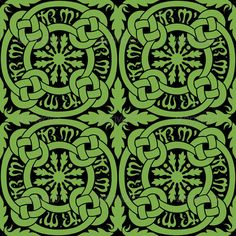
Diseños Celtas
| The Family News Letter Vol. 2 |
|
Memorial Day 2010 The Lost Child Just a Couple of Not So Ordinary Joes Updates
|
Tipperary's Children The Vee County Tipperary, Ireland |

Diseños Celtas |
||
Now Available!
On June 3rd The National Archives of Ireland made the 1901 Census available online. Click
on the link below and be sure to select the 1901 census.
http://www.census.nationalarchives.ie/
Memorial Day 2010

John McCrae, 1915
In Flanders fields the poppies blow
Between the crosses, row on row,
That mark our place; and in the sky
The larks, still bravely singing, fly
Scarce heard amid the guns below.
We are the Dead. Short days ago
We lived, felt dawn, saw sunset glow,
Loved and were loved, and now we lie
In Flanders fields.
Take up our quarrel with the foe:
To you from failing hands we throw
The torch; be yours to hold it high.
If ye break faith with us who die
We shall not sleep, though poppies grow
In Flanders fields.I
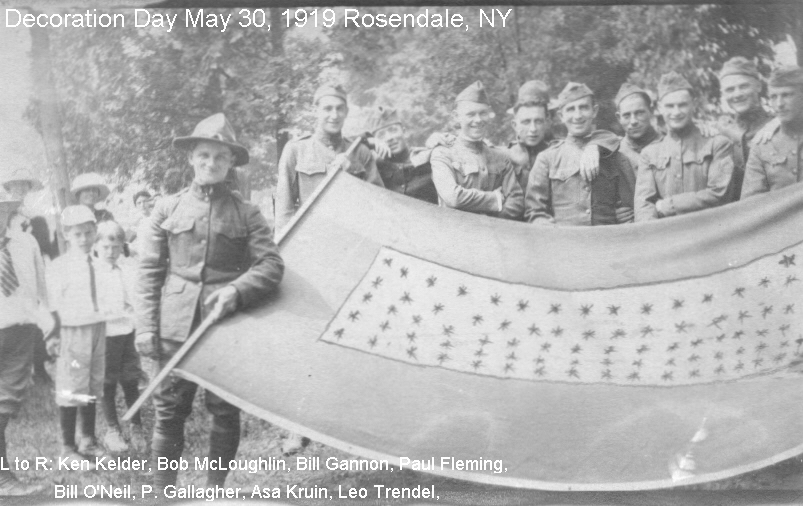 Memorial Day, which was once known as
Decoration Day has it's
origin in the days following the Civil War.
General John Logan commander of the Grand Army of
the Republic first made the proclamation in 1868 and is credited with
establishing May 30th as the official day. The day was set aside as a day
of remembrance for those who died in the defense of their nation by placing
flowers on the graves of soldiers. Through the efforts of Moina Michael,
poppies became the flower of choice after the Great War in 1919, and the idea
was adopted by veterans groups shortly thereafter.
Memorial Day, which was once known as
Decoration Day has it's
origin in the days following the Civil War.
General John Logan commander of the Grand Army of
the Republic first made the proclamation in 1868 and is credited with
establishing May 30th as the official day. The day was set aside as a day
of remembrance for those who died in the defense of their nation by placing
flowers on the graves of soldiers. Through the efforts of Moina Michael,
poppies became the flower of choice after the Great War in 1919, and the idea
was adopted by veterans groups shortly thereafter.
As a child during the 1950's I remember the veterans parading through the streets of my town in Queens NY, just as they did in great numbers throughout the country. At the front of the line were the Spanish War Veterans, followed by the veterans of the Great War (WW1) and WW2. Marching toward the town memorial past throngs of cheering spectators, these proud men, many still in their thirties, still showed the kind of precision reminiscent of a West Point blue line.
Decoration Day 1919 Rosendale, NY
As a young scout, remember marching with these men and feeling so proud and honored that I was allowed to be included in what was clearly their day.
The years went by, the young men began to age and pass on, and an increasingly unpopular war in Southeast Asia, took it's toll on the country. Crowds dwindled, the remembrances decreased, Decoration Day became Memorial Day now part of a weekend holiday. Regardless of the politics involved or the debate about just cause, let us pause for a moment and give thanks to those men, living and dead, who have given their last full measure of devotion so that that nation might live.
WW1
In The Service Of His Majesty
Great Britain
William Paul Sullivan
William Paul Sullivan, or Will Paul as he was known, was the son of Paul Sullivan. He came to America in 1908 with his Uncle Charlie, who was returning from visiting his childhood home in Clogheen Co. Tipperary, Ireland. When the war began in Europe, he left America to join the British Army. At the end of the war he returned to America and worked as a farm laborer in Ulster County, NY. On September 21st 1934 after being reported missing the night before, he was found dead at the bottom of a well from accidental drowning. It was his cousin, Patrick Fleming who petitioned the British Government for a memorial stone the marks his grave. He is buried at St. Charles Borromeo Church Gardiner, NY.
United States of America
Thomas Fleming
Tom was drafted into the army in 1917 and left for France in the summer of 1918. He was part of a medical battalion treating wounded soldiers. In late October 1918, he was transferred to Base Hospital 34 as an ambulatory attendant and while there, became infected with the Spanish Influenza. He died 0n November 3, 1918 shortly before the armistice was signed on November 11, 1918. His body was returned to the states and he is buried in the family plot in Rosendale, NY.
Below is the heart breaking inquiry by Joseph Fleming about his brother Tom's last moments. February 8, 1919.
Paul Fleming
Like so many young men in Rosendale, Paul Fleming was drafted into the army in 1917 to and began training with an artillery unit before his departure to the the trenches of France. Paul returned from France and opened a photography studio. He married Lottie DuBoise on May 3, 1936 and passed away in New York City on December 15,1957. Thanks to Maureen Miller I have copies of many of his letters.
Patrick Fleming
Patrick Fleming the youngest child of James and Mary Fleming, was born on 1897. He enlisted in the US Army on May 23,1917, and was sent to Camp Travis, Texas to join a cavalry detachment. Before being deployed to France he was given an honorable discharge for reasons of disability. He and his wife Mary Violet both worked for the US Postal Service in Platekill, NY retiring in 1961. I had the great pleasure of meeting Patrick and Vi in 1975.
Edward Sullivan
In 1918 my father, Ed Sullivan, was the last of the three Sullivan boys to leave St. John's home in Brooklyn his brother Joe left the year before. Since he was still a minor age 14, he was placed under the care of his older brother Arthur who was then 21. When my father had passed in 1967, I remember Arthur and Joe reminiscing about his enlistment in the navy. My father had asked his brother Arthur to attest that he was sixteen and therefore of age to join, something he refused to do. Not to be deterred, my father went down the chain of command and enlisted Joe's help. Because they were so close, he seemed to be more persuasive and Joe agreed to help. Edward Sullivan enlisted in the navy in 1919 sometime before the Armistice, thereby becoming on of the youngest veterans of the Great War at age 15. My father is buried in Pinelawn National Cemetery NY.
William Sullivan
Arthur Sullivan
WW2
Michael Duffy
Terence Duffy
Paul Lyons
Vietnam
Dennis Sullivan
The Lost Child
William Edward Sullivan
How does one go about finding a lost child? In this case not the ordinary way to be sure. You have to know that the child even existed in the first place, and that is where the story begins. A little over twenty years ago (1988), I remember sitting with my Uncle Joe and we were discussing family relationships. Out of the blue he said to me "You know, I seem to remember having an Uncle Ed in Staten Island but I don't know what ever happened to him". I knew about his Uncle Charles in Quincy, and I remembered that there was some kind of family connection in Rosendale NY, but that was all I knew of my grandfather Christopher's family. I remember making a note of this and storing it with what little information I had at the time. That same year before I made my first visit to Ireland I took a copy of the cemetery deed and paid a visit to the resting place of Christopher and Catherine Sullivan in Calvary Cemetery in Maspeth, NY. I don't honestly know what I was expecting, but I was devastated to find an unmarked grave. The next month while visiting the ancestral home of both the Duffys and the Sullivans and made a promise to myself that someday I would document our family's history.
Just before his death in March of 1993, my cousin Arthur Sullivan called me and explained that he was looking into an Irish passport and needed some information about the Sullivan side of the family. He told me he had already found Christopher and Catherine Sullivan in the 1910 Census and this piqued my interest. However it wasn't until 2003 when I began in earnest to uncover the family history and find the answers to questions that I had been asking myself ever since I can remember. Who am I and where did I come from?
My brother Ed had recently received a family chart from Catherine Smith in England detailing the overseas links to the family that I had never seen before and there began my mission to rebuild the family history lost to us so many years ago. Now I knew that my grandfather had seven siblings including a sister that lived in Rosendale NY. The Sullivan family as we knew it looked like this: William Sullivan married Margaret Spotwood, children were Paul, Honora, William, Mary, Catherine, Christopher, Anna, and Charles. In addition, thanks to Catherine Smith, I now had information that went back an additional generation to Martin Sullivan. But still no Edward.
While visiting
Maureen Miller in Rosendale late in 2004 we poured through a collection of old
family postcards and as I scanned them into a
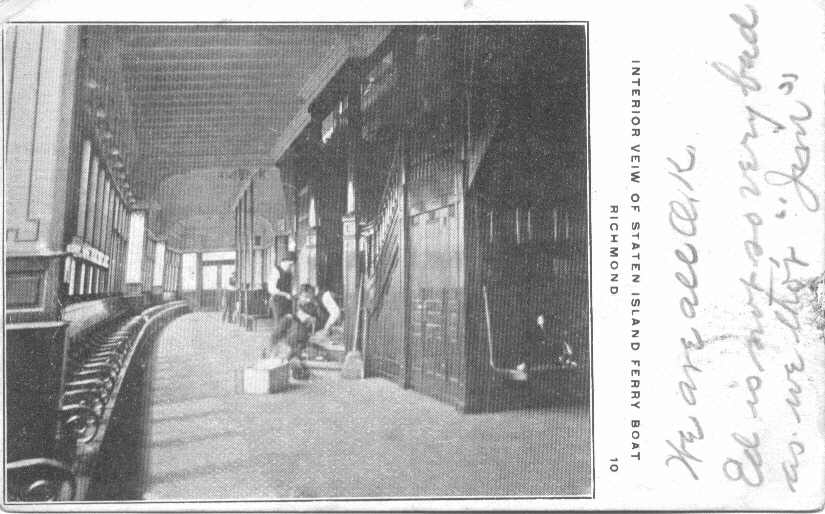 file on my computer she showed me
one that postmarked Port Richmond NY January 23 1906
file on my computer she showed me
one that postmarked Port Richmond NY January 23 1906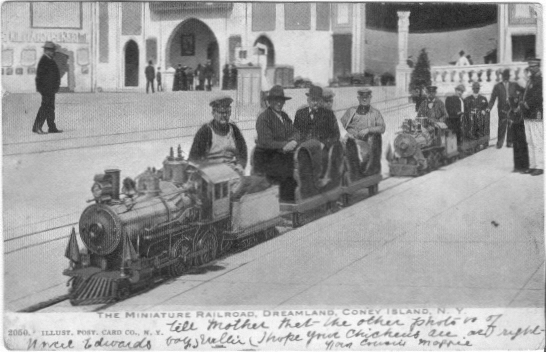 from James Fleming. On the front side
was a reference to Ed and his health and I wondered if I finally had my
first evidence about the uncle Ed I had been searching for. Now I wanted
to examine all the postcards I had more carefully to see if there were any
other clues that would help me narrow the search and I had one. One card
post marked June 28, 1905 with a notation on the bottom as follows. "Tell Mother
that the other photo is of Uncle Edwards boy Willie. I hope your chickens
are all right. Your cousin Maggie." Not only a reference to Uncle
Ed, but a child named William as well. Stunning!
from James Fleming. On the front side
was a reference to Ed and his health and I wondered if I finally had my
first evidence about the uncle Ed I had been searching for. Now I wanted
to examine all the postcards I had more carefully to see if there were any
other clues that would help me narrow the search and I had one. One card
post marked June 28, 1905 with a notation on the bottom as follows. "Tell Mother
that the other photo is of Uncle Edwards boy Willie. I hope your chickens
are all right. Your cousin Maggie." Not only a reference to Uncle
Ed, but a child named William as well. Stunning!
Where, I thought, do I go from
here? Rather than plow through the birth registry for young William, I tried
another strategy. The postcard
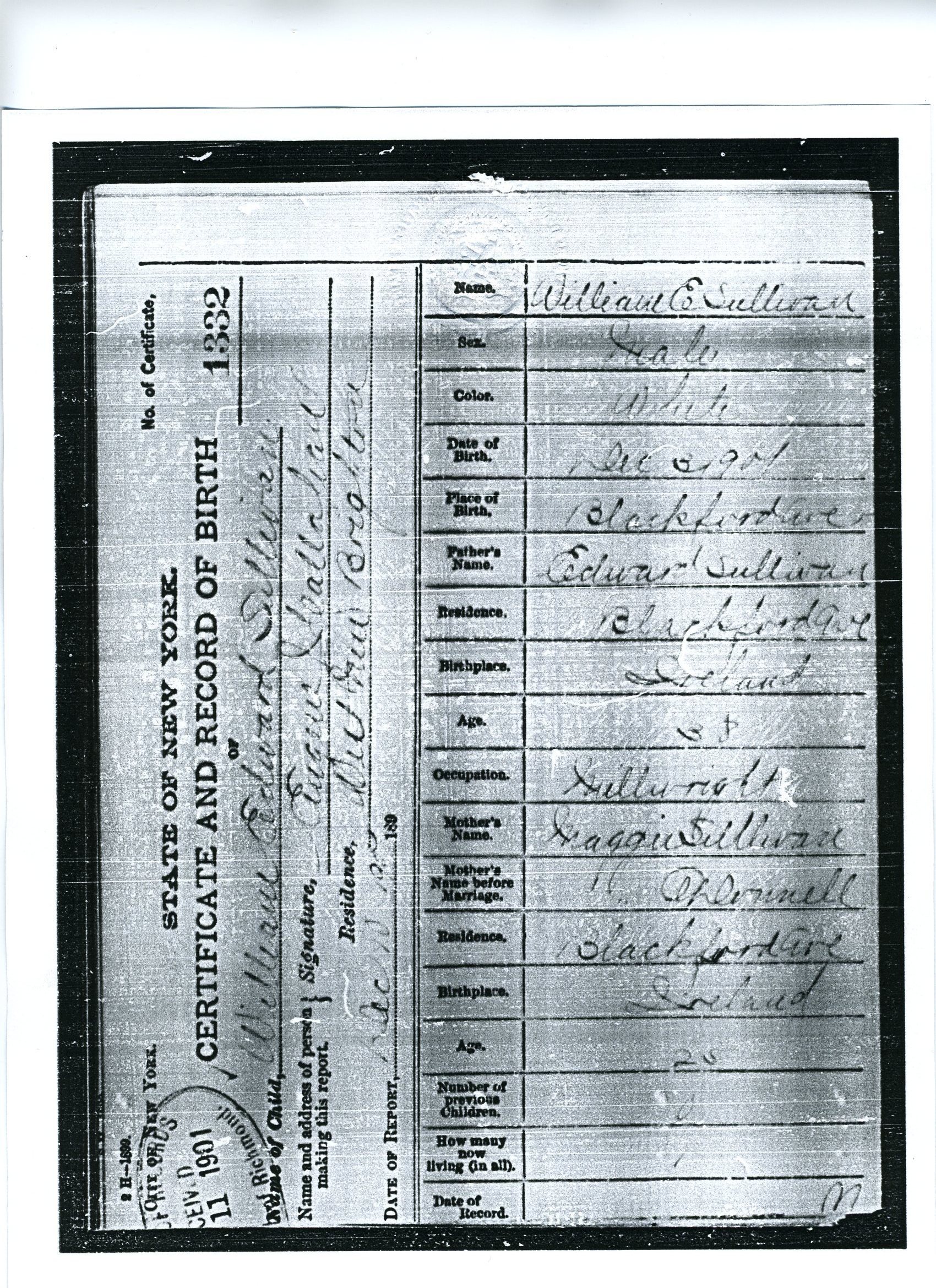 from 1906 was an obvious reference to Ed's
health. And knowing that family members would probably not travel such
great
from 1906 was an obvious reference to Ed's
health. And knowing that family members would probably not travel such
great
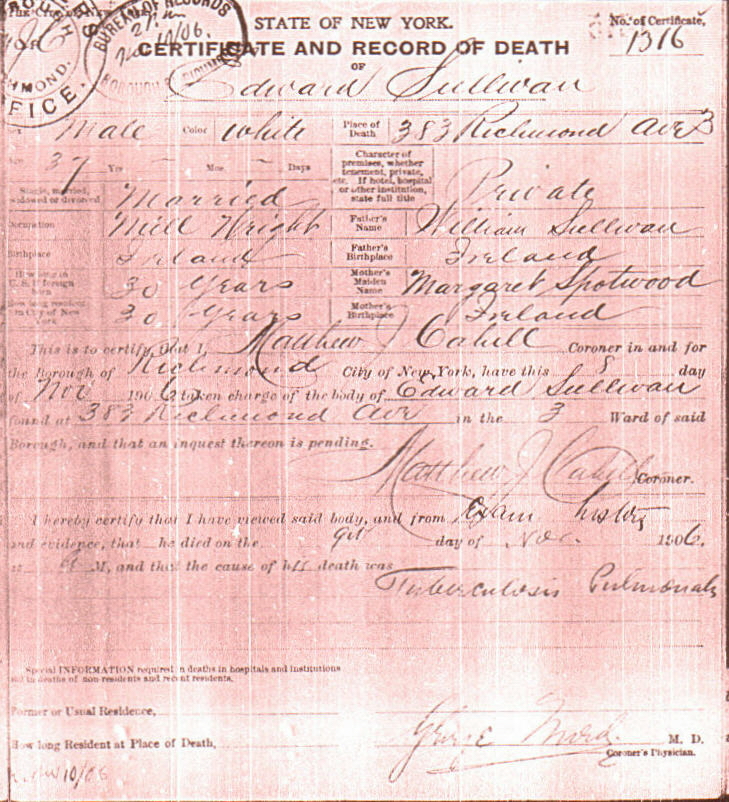 distances if not for the great concern for the possibility of that
person's demise. Armed with this information I visited the New York City
Archives on Chambers Street and checked the index for death certificates for
Richmond County NY 1906 and found one for Edward Sullivan dated November 8,
1906. Father was William Sullivan and Mother Margaret Spotwood. At last I found the Uncle Ed that my Uncle Joe had talked
about all those years before. Now to find William.
Using
the birth index for Richmond County and working backwards from 1905 I searched
for William Sullivan and found his birth certificate. William Edward
Sullivan was born to Edward Sullivan and Margaret O'Donnell on December 3, 1901
just three months before my Uncle Joe. Now another piece of the family puzzle had been put
in place by revealing Margaret O'Donnell's place in the family tree. Margaret O'Donnell, my grandmother's sister,
married Edward Sullivan. And Edward
Sullivan and Margaret O'Donnell not only came from the same town
(Clogheen), but they lived on the same road (Cockpit Lane). I would have been so proud to have
given him that information while he was still alive. The only surviving
family photograph that I have of Christopher Catherine and family was given to
my by my Uncle Joe. It was taken shortly after his birth and I suspect it
was taken at his brother Edward's house in Staten Island NY.
distances if not for the great concern for the possibility of that
person's demise. Armed with this information I visited the New York City
Archives on Chambers Street and checked the index for death certificates for
Richmond County NY 1906 and found one for Edward Sullivan dated November 8,
1906. Father was William Sullivan and Mother Margaret Spotwood. At last I found the Uncle Ed that my Uncle Joe had talked
about all those years before. Now to find William.
Using
the birth index for Richmond County and working backwards from 1905 I searched
for William Sullivan and found his birth certificate. William Edward
Sullivan was born to Edward Sullivan and Margaret O'Donnell on December 3, 1901
just three months before my Uncle Joe. Now another piece of the family puzzle had been put
in place by revealing Margaret O'Donnell's place in the family tree. Margaret O'Donnell, my grandmother's sister,
married Edward Sullivan. And Edward
Sullivan and Margaret O'Donnell not only came from the same town
(Clogheen), but they lived on the same road (Cockpit Lane). I would have been so proud to have
given him that information while he was still alive. The only surviving
family photograph that I have of Christopher Catherine and family was given to
my by my Uncle Joe. It was taken shortly after his birth and I suspect it
was taken at his brother Edward's house in Staten Island NY.
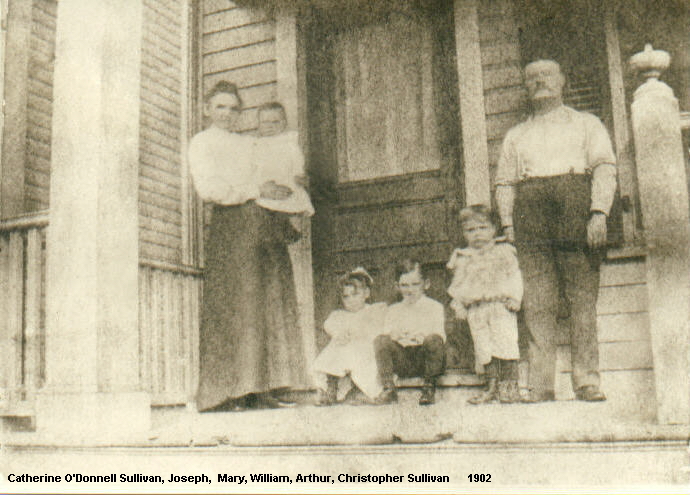 About two years after
the death of her husband, Margaret left New York for Barre, Massachusetts
and married George Graton having two sons Burton and Robert (1910 Worchester Co.
MA Census). I have been able to find William in both the 1920 and 1930
Massachusetts census, but I know little else about him. As far as I know,
he did not marry, and I am not sure what if any contact he had with the Sullivan
family although it is possible that he did have some contact with his cousin
Mary Sullivan (Christopher's daughter). William did have the benefit of
some sort of family life unlike my father and his siblings. The deaths of
Christopher and Catherine at such an early time of their childhood had profound
effects that would follow all of them throughout their lives. But I
am going to risk speculating that William did lack one very important connection
in his lifetime, one all too often repeated in our family's American experience,
that being a wider relationship with the family whose name he bears. A lost
child.
About two years after
the death of her husband, Margaret left New York for Barre, Massachusetts
and married George Graton having two sons Burton and Robert (1910 Worchester Co.
MA Census). I have been able to find William in both the 1920 and 1930
Massachusetts census, but I know little else about him. As far as I know,
he did not marry, and I am not sure what if any contact he had with the Sullivan
family although it is possible that he did have some contact with his cousin
Mary Sullivan (Christopher's daughter). William did have the benefit of
some sort of family life unlike my father and his siblings. The deaths of
Christopher and Catherine at such an early time of their childhood had profound
effects that would follow all of them throughout their lives. But I
am going to risk speculating that William did lack one very important connection
in his lifetime, one all too often repeated in our family's American experience,
that being a wider relationship with the family whose name he bears. A lost
child.
William Sullivan passed away in Massachusetts February of 1957.
Just a Couple of Not So Ordinary Joes
Much of my interest in the discovery of my family's history may be attributed primarily to two individuals, one of whom I knew well, and one who died when I was six months old. Both men are important in our family's tree.
Joe Sullivan
My Uncle Joe Sullivan's life spanned the terms of 17 Presidents, four wars, a Great Depression and virtually the entire history of manned flight from its infancy at Kitty Hawk well past the one giant leap for mankind on the moon. And this was someone that remembered the Brooklyn Dodgers when they played in Brooklyn. Not just at Ebbitts Field, when it opened in 1913, but before that when they played at Washington Park on Third Ave and Third Street in Brooklyn (turd and turd he would say in Brooklinenese). A truly remarkable period of time and yet he managed to keep it all in stride. For most of my life my Uncle Joe was the only source of information about the Sullivan family. He never wrote about his experiences, he was more at ease with the oral tradition like the great chroniclers of years gone by. His ability to sit for hours and relate his life experiences was what endeared him to my brothers and me. His life began in Brooklyn, NY in 1902 and even after he married Ester Sullivan (not sure where this branch of the Sullivan's originate, see John F and Ellen T below) moved to Boston, and began a family, he never forgot his beloved Brooklyn. My Uncle Joe was a man of tradition, small traditions but these were the constants in his life. Whether it was Boston Beans and franks on Saturday or his daily Ball and a Beer (shot of whiskey and a beer), there were certain rituals that had to maintained. It was what made the world go round. Traditions are the rituals we develop in an uncertain environment in order to bring stability and order to our lives and Joe had his.
I'm going
to take some liberties and try to understand what it was that helped shaped his
state of mind and that requires going back to his childhood. Joe lost his
parents to tuberculosis when he was ten years old, and like his brothers and
sisters never completely recovered from the
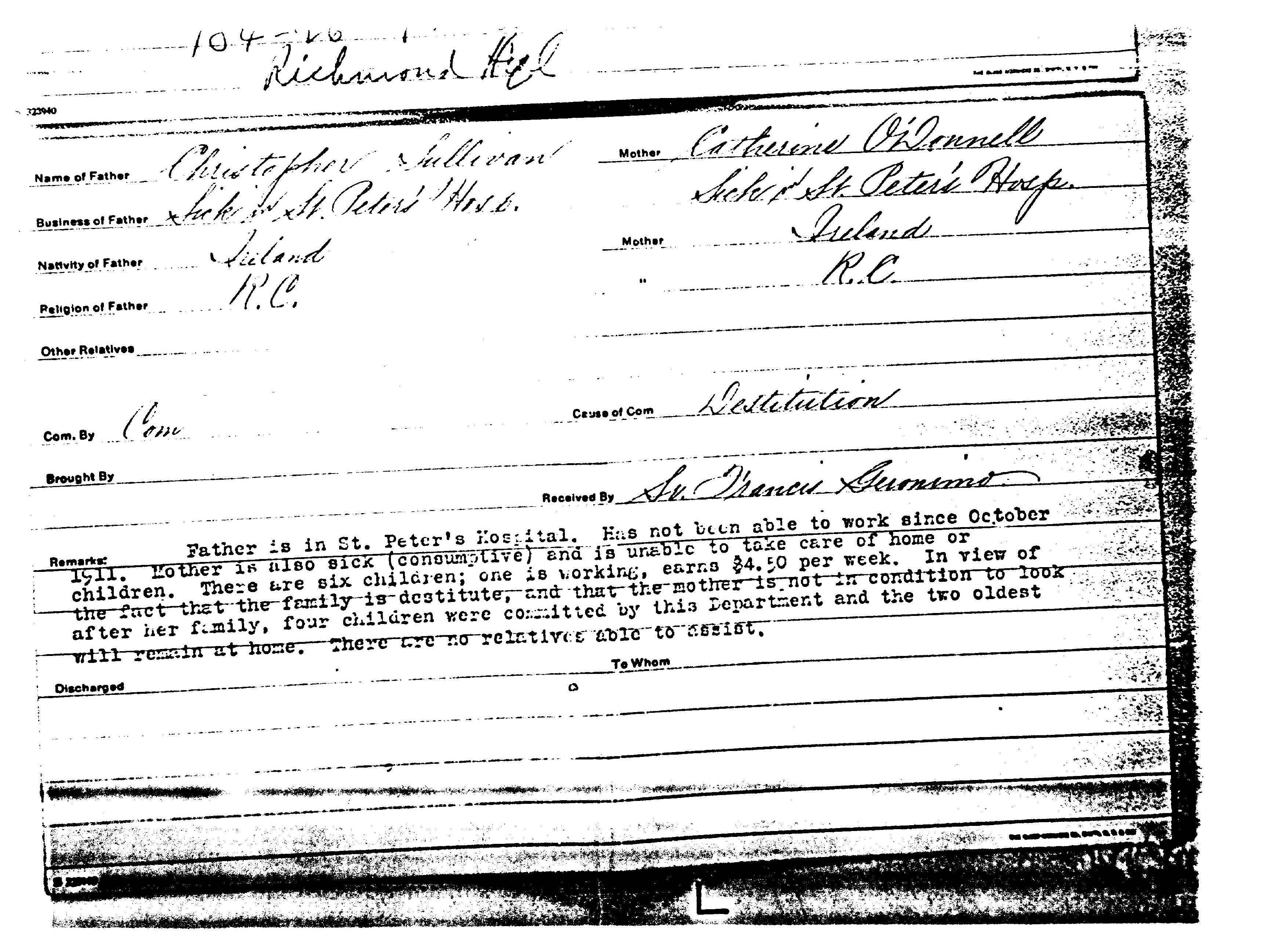 experience.
The neighboring Feis family took care of their family needs in the short
tern as did Martha Lemann, Arthur's God Mother (the woman we called Grandma) .
Bill was old enough to work and declare independence, while Mary and
Margaret were sent to live with Christopher's brother, Charles and his wife
Margaret in Quincy MA. Joe was admitted to St John's Home in Brooklyn,
NY on January 8, 1912 along with his two brothers Arthur and Edward. because both parents
had been committed to St Peter's hospital in Brooklyn, NY and
unable to care for their children. Joe spent six years at St
John's Home being released on March 2, 1918, his sixteenth birthday, in the care
of his brother Arthur. Of all the discussions we had through the years
about St John's I never heard him say anything negative about his time there.
And that seem to hold true for my father, Ed and my Uncle Arthur as well. When he
came to New York for a reunion at St John's home around 1970, he sat with
us for hours relating how impressed he was with the home and how much he enjoyed
talking to the people who were there around the same time as he was.
experience.
The neighboring Feis family took care of their family needs in the short
tern as did Martha Lemann, Arthur's God Mother (the woman we called Grandma) .
Bill was old enough to work and declare independence, while Mary and
Margaret were sent to live with Christopher's brother, Charles and his wife
Margaret in Quincy MA. Joe was admitted to St John's Home in Brooklyn,
NY on January 8, 1912 along with his two brothers Arthur and Edward. because both parents
had been committed to St Peter's hospital in Brooklyn, NY and
unable to care for their children. Joe spent six years at St
John's Home being released on March 2, 1918, his sixteenth birthday, in the care
of his brother Arthur. Of all the discussions we had through the years
about St John's I never heard him say anything negative about his time there.
And that seem to hold true for my father, Ed and my Uncle Arthur as well. When he
came to New York for a reunion at St John's home around 1970, he sat with
us for hours relating how impressed he was with the home and how much he enjoyed
talking to the people who were there around the same time as he was.
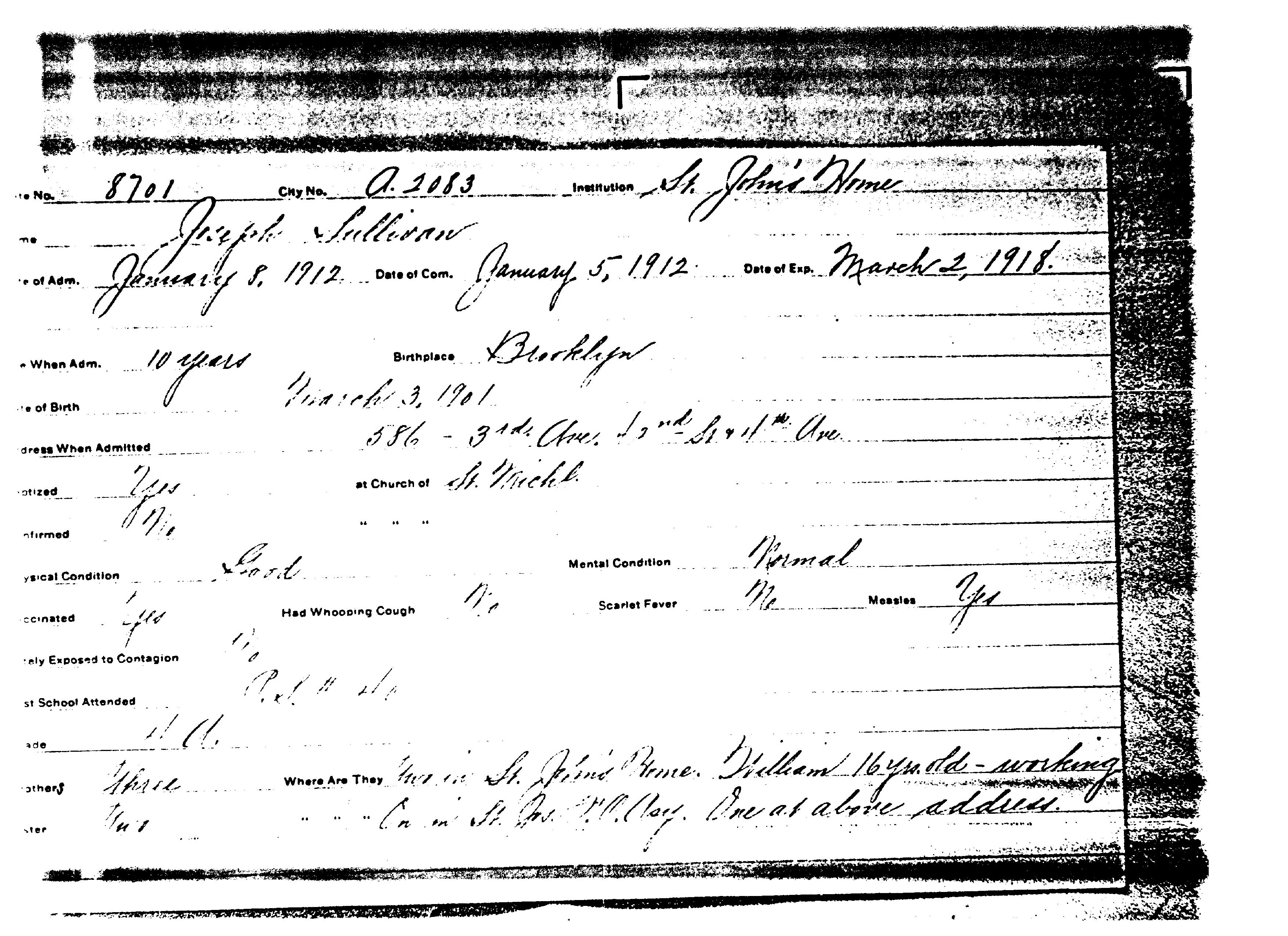 Ed and Joe
were as close as any two people could be, not just as brothers, but as best friends. After the Ed's
death it was Joe who assumed a larger role with Ed's children. His
visits to New York were always an event for us, and the same held true for the
Michigan and Oregon part of the family as well. He was always the center
of attention, and rightfully so. He possessed the ability to
carry a conversation with young and old alike truly bridging the generations. Once
I asked Joe what he remembered about his parents, and he went silent. I'll
never be sure if it was the failure of a ten year old child's memory, or if in fact his
recollections were all too vivid after all those years. In any case I did
not pursue the conversation thinking that I would have an opportunity
another time. But unfortunately it never happened. Sometimes things
like this are better left undone.
Ed and Joe
were as close as any two people could be, not just as brothers, but as best friends. After the Ed's
death it was Joe who assumed a larger role with Ed's children. His
visits to New York were always an event for us, and the same held true for the
Michigan and Oregon part of the family as well. He was always the center
of attention, and rightfully so. He possessed the ability to
carry a conversation with young and old alike truly bridging the generations. Once
I asked Joe what he remembered about his parents, and he went silent. I'll
never be sure if it was the failure of a ten year old child's memory, or if in fact his
recollections were all too vivid after all those years. In any case I did
not pursue the conversation thinking that I would have an opportunity
another time. But unfortunately it never happened. Sometimes things
like this are better left undone.
December 2010 will mark the 10th anniversary of his passing, just three months shy of his 98th birthday. A remarkable span of life. He always told us in his uniquely humorous way "When I get to 100, I'm going to sell" (a reference to his days as a Wall Street messenger in his youth). He may have sold short, but he most certainly came out ahead of the game. As we all did for knowing him.
He is both remembered and missed.
Joe Fleming
Joe Fleming is someone who I only
got to know rather late in my life through his writing and poetry.
Most of what I know about Joe Fleming as well as
the Sullivan family
can be
attributed to the Fleming family through his niece, Maureen Fleming Miller. Here is
how the family relates in our family tree. My grandfather Christopher
Sullivan and Maureen's grandmother Mary Sullivan were brother and sister.
Mary Sullivan left Clogheen Co. Tipperary in 1873 at the age of 16 and emigrated
to New York in the United States. She followed James Fleming who had left
Ireland several years before after a failed uprising in Tipperary. James
worked on the railroad in Canada and New York State, eventually settling in
Kingston, NY where Mary joined him and they were married in 1873. Shortly
thereafter James found work in the cement mines in Rosendale and he and Mary
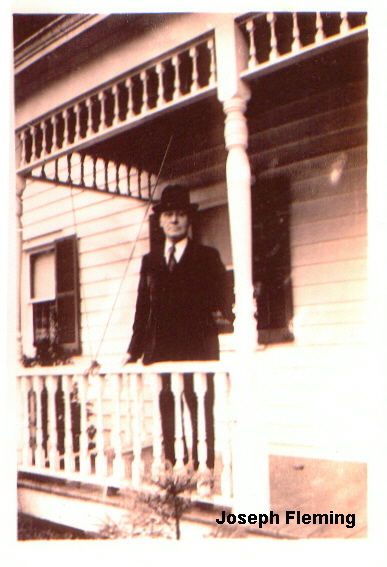 settled in and raised their family.
settled in and raised their family.
Joe Fleming was born on July 4, 1881 the fifth of twelve children. Though he lacked much formal education he was an avid reader and possessed an above average command of the English language as well as writing skills. He had a love for poetry, and honed his skills through the years keeping his creations in an ordinary composition book. Joe Fleming's poetry spans most of his adult life beginning in 1913 through his death in 1950.
Like most men in Rosendale in the late 19th century, he worked for a time in the James B. James cement mines which produced great quantities of high quality limestone used in the construction of buildings and bridges in New York City. Most of Joe's family though, was connected in one way or another with the printing trade, brothers Tom, Paul and Patrick running the presses through the years. However Joe's talent for writing comes to the surface early on, eventually penning a column in The Rosendale News under the banner Do You Remember from 1938 through 1943. He later became Assistant Editor of that paper on July 7,1939 while maintaining his full time position at Vassar College. A compilation of his columns as well as his A Story of James Street which documents his life and times on James Street in Rosendale in the late 19th century, has been published in pamphlet form indexed by Linda Tantillo and is available at the Rosendale Library.
Of interest to me however, is his history of the Fleming and Sullivan families which he was in the process of publishing shortly before his death. Joe alluded to the fact that he had done extensive research into the Fleming and Sullivan families, recounting much of the firsthand experiences of his parents. Some tantalizing evidence of what he had accumulated appears in the letter below, which he wrote shortly before his death in August 1950.
In time I hope to post more remembrances and poetry from Joe Fleming as well as profiling his extraordinary family.
1 CHHS Natural News
July 28, 1950
Dear Father Doyle,
Many thanks for the words of encouragement contained in your kind letter July 24th. Sorry that Iona College undertakes no publication, however I will try to promote my little Irish American ego and will sound out the sources recommended by you.
Publication would be simplified were I to get my manuscript typed a peddle it around to commercial press who like to needle things up for reader amusement in a way that sometimes lowers the public estimate of the matter under consideration.
For this reason I prefer that my book be considered by Catholic sources, sympathetic to and understanding Irish nature it’s vagaries, contradictions, abilities and in the aggregate it’s warmth of heart irrepressible talents and spirits.
However, it will take some time before my book will appear in print as it needs various revisions before adaptable as I originally started it as a private family history containing genealogical data not likely to interest the general reader.
Although my father frequently belittled his ancestry by quoting Bobby Burns: "Me ancient but ignobled blood has coursed thru scoundrels since the flood". He nevertheless was very proud of his ancient lineage as a Waterford man it may interest you to know that my father 1846-1910, grew up at Carrick on Suir Co. Waterford Ireland.
As our name implies we as Flemings our ancestors were crossbow men under Strongbow in the Norman invasion of 1066 AD. They intermarried with certain of the De Le Fleur, Fitzgerald, Phelan, and O’Sullivan families and othe of course. My own mother was an O’Sullivan a native of Clogheen, Co. Tipperary, Ireland, and as father used to say the Flemings are Irish as the Irish there are.
As boys, my father and Admiral Brisford of Curraghmore claimed cousinship through the De Le Voes or Powers family. Dan Humerbery who first occupied the Guild Chair at Catholic University at Washington D.C. is also said to have been a relative of ours. Father and his brothers and then comrades used to confession and communion facilities of the French Monks of Mt. Millerary while in the field during the rising of ’67 as did my mother’s brothers from Tipperary side of the mountain. Father after walked to Waterford City on Sundays. He later worked in England – came to America in 1868, participated in the raid on Canada, and worked across the continent on the railroads in it till his marriage in 1873.
A profound scholar a brilliant debater, the father of 12 children he was a drudge and a slave all his life. Only one grandchild bears the old name and father’s three grandchildren are girls. Inevitably the name must die. Conscious of this the driving force of my literary efforts are furiously the rear guard action of a retreating dying family who viewed the world constructively for a thousand years with credit, honor, and distinction.
Pray for me.
Thank you for returning the list of books as the books are all crated and I have no other list. I note your interest account in the four titles you marked and will remember you when I make a dissertation of father’s library. Again thank you for your kindly interest in my efforts.
I remain very sincerely,
Joseph A. Fleming
Rosendale
Ulster Co.
New York
UPDATES
John J and Nora T Sullivan Census Images
* A error was made in the previous listing as John F and Ellen T and the correction has been made.
John J Sullivan is the father of Ester Sullivan and father-in-law to Joe Sullivan. John was born in England, although the 1930 Census specifically states Wales as his birthplace. His family emigrated to the United States sometime between 1875 and 1884 the census sheets vary depending on who was responding to the census taker's questions (this is not an uncommon occurrence). The marriage of John J and Nora T takes place in 1899 or 1900 I'll try to confirm the exact date as well as marriage and citizenship information in the future. Nora was born in Massachusetts as was her mother. Nora's father was born in Ireland, and the notation reads Gaelic (South Ireland). During their marraige, six children were born, but four survived. The Census images as well as the transcripts are listed in the space below. Please note that as yet I have been unable to locate the principles in the 1900 Census, but I will continue the research.
1910 US Federal Census Boston, Massachusetts
1920 US Federal Census Boston, Massachusetts 1930 US Federal Census Boston, Massachusetts
Elizabeth Callan Update
Last newsletter I wrote that I believed that Elizabeth Callan Duffy lived at house number 7 in Drumlandrick (Broomfield, Monaghan). On June 3rd the Ireland Census of 1901 became available and one of my first goals was to confirm whether or not my assertions were correct. For some unexplained reason , Elizabeth Callan who would have been about 15, was not listed on the 1911 census. But when I researched the same family in the 1901 census she was listed. We can assume that this is the same Elizabeth Callan that married Terance Duffy by cross referencing census returns and the ship passenger lists available. Also noticeable was the absence of Luke Callan on the earlier census return so it is safe to speculate that he had passed sometime between 1896 and 1901. The link below shows the family as it appeared in 1901.
http://www.census.nationalarchives.ie/pages/1901/Monaghan/Broomfield/Drumlandrick/1628918/